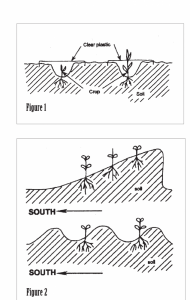digitS'
Garden Master
This post may be of little help to most but the article linked and the entire scope of the ideas inspired me to put it here on TEG.
I like mountains and enjoy living where I can see them, most any old time. It's a challenge enjoying gardening at higher elevations and yet, I don't live at a very high elevation, at 2,000 feet. Still, the proximity to mountains and the northern latitude provide some challenges.
Some places like Colorado really look difficult to me. Sun exposure, with all those mountains and the possibility of sudden, often localized, often severe "weather events." Hail, snow, wind storms - all may occur throughout that up-and-down terrain. The thin air means that there is often a great deal of difference between day and night temperatures. "Mile High?" You know, officially Denver has warmer growing seasons than here (by a few degree days). But, I have a slight advantage - my hours of darkness are a little shorter because of latitude . (Now explain to me why I have trouble with marmots but they only live above 6,000 feet in Colorado
. (Now explain to me why I have trouble with marmots but they only live above 6,000 feet in Colorado  .)
.)
I was looking at an article in Planet Natural (Montana company) yesterday morning and came across this: https://www.planetnatural.com/high-altitude-gardening/ That gardener is at 7,000 feet in New Mexico.
Steve
I like mountains and enjoy living where I can see them, most any old time. It's a challenge enjoying gardening at higher elevations and yet, I don't live at a very high elevation, at 2,000 feet. Still, the proximity to mountains and the northern latitude provide some challenges.
Some places like Colorado really look difficult to me. Sun exposure, with all those mountains and the possibility of sudden, often localized, often severe "weather events." Hail, snow, wind storms - all may occur throughout that up-and-down terrain. The thin air means that there is often a great deal of difference between day and night temperatures. "Mile High?" You know, officially Denver has warmer growing seasons than here (by a few degree days). But, I have a slight advantage - my hours of darkness are a little shorter because of latitude
I was looking at an article in Planet Natural (Montana company) yesterday morning and came across this: https://www.planetnatural.com/high-altitude-gardening/ That gardener is at 7,000 feet in New Mexico.
Steve

